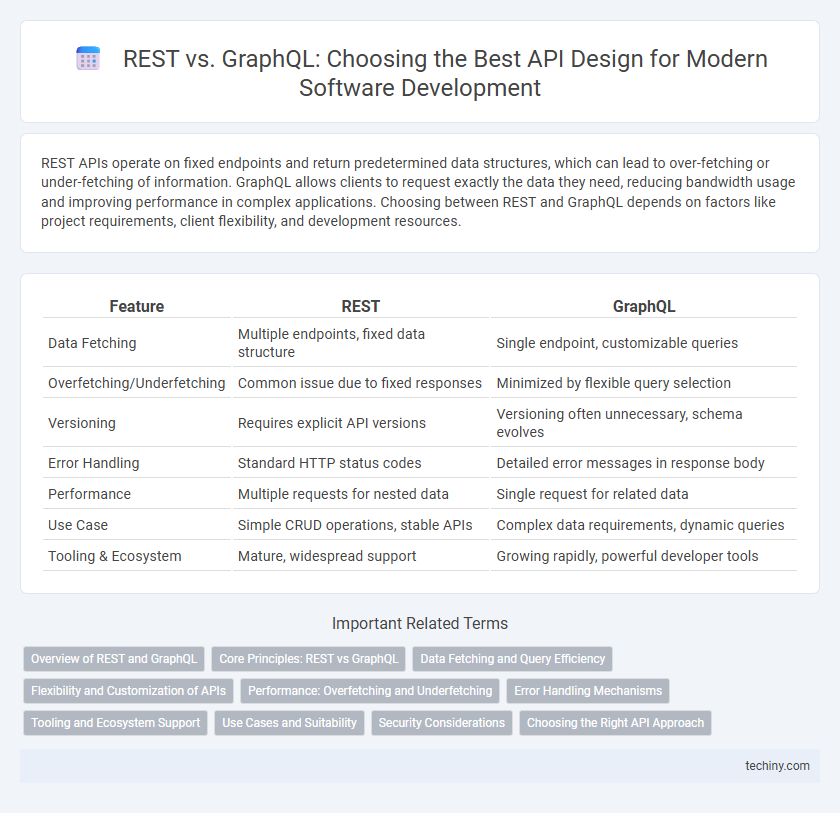REST APIs operate on fixed endpoints and return predetermined data structures, which can lead to over-fetching or under-fetching of information. GraphQL allows clients to request exactly the data they need, reducing bandwidth usage and improving performance in complex applications. Choosing between REST and GraphQL depends on factors like project requirements, client flexibility, and development resources.
Table of Comparison
| Feature | REST | GraphQL |
|---|---|---|
| Data Fetching | Multiple endpoints, fixed data structure | Single endpoint, customizable queries |
| Overfetching/Underfetching | Common issue due to fixed responses | Minimized by flexible query selection |
| Versioning | Requires explicit API versions | Versioning often unnecessary, schema evolves |
| Error Handling | Standard HTTP status codes | Detailed error messages in response body |
| Performance | Multiple requests for nested data | Single request for related data |
| Use Case | Simple CRUD operations, stable APIs | Complex data requirements, dynamic queries |
| Tooling & Ecosystem | Mature, widespread support | Growing rapidly, powerful developer tools |
Overview of REST and GraphQL
REST (Representational State Transfer) is an architectural style for designing networked applications, emphasizing stateless communication, resource-based URLs, and standard HTTP methods such as GET, POST, PUT, and DELETE. GraphQL is a query language and runtime for APIs that enables clients to request exactly the data they need, reducing over-fetching and under-fetching issues common in REST. While REST relies on fixed endpoints returning predetermined data structures, GraphQL uses a single endpoint with flexible queries, enhancing efficiency in complex data retrieval scenarios.
Core Principles: REST vs GraphQL
REST architecture relies on stateless communication, standardized HTTP methods, and resource-based URIs to manage client-server interactions, emphasizing predefined endpoints and structured responses. GraphQL centers around a flexible query language that allows clients to request precisely the data they need, reducing over-fetching and under-fetching through a single endpoint. Core principles distinguishing REST and GraphQL include REST's emphasis on resource manipulation via fixed endpoints versus GraphQL's schema-driven queries that enable dynamic data retrieval.
Data Fetching and Query Efficiency
REST APIs often require multiple endpoints and over-fetching or under-fetching of data, leading to inefficient network usage. GraphQL allows clients to specify exactly which data fields they need in a single query, reducing the number of requests and optimizing data transfer. This precise data fetching enhances query efficiency, especially in complex applications with nested data requirements.
Flexibility and Customization of APIs
REST APIs offer predefined endpoints which can limit flexibility when clients require specific data structures, leading to over-fetching or under-fetching issues. GraphQL enables precise queries by allowing clients to request exactly the data needed, optimizing network usage and customization. This adaptability makes GraphQL ideal for complex applications demanding tailored API responses and efficient data retrieval.
Performance: Overfetching and Underfetching
REST APIs often suffer from overfetching or underfetching as clients receive fixed data structures, leading to unnecessary data transfer or multiple requests. GraphQL addresses these issues by enabling clients to specify exact data requirements in a single query, optimizing response size and reducing the number of network calls. This selective data fetching enhances overall application performance and decreases latency in data retrieval.
Error Handling Mechanisms
REST APIs typically rely on HTTP status codes and separate error response bodies to communicate issues, enabling straightforward error detection and handling at the client side. GraphQL consolidates errors within the response's "errors" field, often alongside partial data, allowing more granular insight into specific failures within a single request. Choosing between REST and GraphQL error handling depends on the need for standardized status codes or detailed per-field error reporting for complex interactions.
Tooling and Ecosystem Support
REST benefits from a mature tooling ecosystem with widespread support in API testing tools like Postman and automation frameworks such as Swagger. GraphQL offers specialized tools like Apollo Studio and GraphiQL that provide advanced query building, real-time error detection, and schema introspection capabilities. While REST tooling excels in simplicity and integration with existing infrastructure, GraphQL tooling focuses on enhanced developer experience and efficient data querying, catering to modern application needs.
Use Cases and Suitability
REST APIs excel in scenarios requiring simple, stateless operations with standardized endpoints, making them suitable for CRUD operations and services with predictable data structures. GraphQL shines in applications needing complex querying capabilities, enabling clients to request exactly the data they need, which is ideal for dynamic, data-intensive user interfaces and real-time updates. Choosing between REST and GraphQL depends on factors like the complexity of data relationships, the need for efficient bandwidth usage, and the flexibility required by front-end development teams.
Security Considerations
REST enforces strict endpoint access controls and benefits from mature security protocols like OAuth 2.0, while GraphQL demands careful query validation to prevent injection attacks and excessive data exposure. Rate limiting and depth limiting are essential in GraphQL to mitigate denial-of-service risks, whereas REST's fixed endpoints naturally limit query complexity. Both architectures require robust authentication and authorization mechanisms, but GraphQL's flexible query nature necessitates more granular permission checks to safeguard sensitive data effectively.
Choosing the Right API Approach
Choosing the right API approach depends on specific project requirements, with REST offering simplicity and wide adoption, ideal for standardized CRUD operations and caching strategies. GraphQL excels in scenarios requiring flexible data retrieval, allowing clients to request exactly the data needed and reducing over-fetching or under-fetching issues. Consider factors like development speed, data complexity, client-server interactions, and long-term maintenance when deciding between REST and GraphQL.
REST vs GraphQL Infographic

 techiny.com
techiny.com